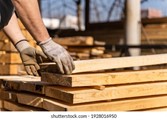As you have come to find, there are hazards and risks associated with manual handling. Now let’s look at some techniques to help you adopt safe manual handling techniques.
|
Plan effectively |
Use safer lifting techniques |
|
When planning to move heavy, bulky or awkwardly shaped materials, ask yourself the following questions before you begin.
|
|
The following video is from Victoria’s State Emergency Service. It provides some clear, simple advice on safe lifting.
The following video from Safe Work Australia discusses strategies for minimising musculoskeletal disorders by changing manual handling tasks.
Hazardous substances must be handled safely. Ensure that you:
- review relevant SDS and know what to do in the event of a spill or other incident.
- follow your workplace’s policies and procedures.
- wear PPE
- handle them carefully to avoid spills.
- move them to the appropriate storage area for safe disposal (as per EMP/SWMS), if you are moving them for disposal.
- report any incidents in line with SDS/SWMS/policies and procedures.
HARRY COMMENT: WITH THE BULLET POINTS ABOVE, CAN YOU PLEASE DRAW THEM IN A GRAPHIC LIKE BELOW WITH AN IMAGE AT THE CENTER.

Watch the following video for some tips on the safe handling of hazardous substances.
Hazardous materials must be handled safely. Ensure that you:
- review the relevant SDS and know what to do in the event of a hazardous materials incident
- follow your workplace’s policies and procedures
- follow relevant SWMS
- understand the site’s hazardous materials plans (for example, asbestos management plan)
- wear PPE
- handle hazardous materials carefully
- if you are moving them for disposal, move them to the appropriate storage area for safe disposal or recycling (as per EMP/SWMS)
- report any incidents in line with SDS/SWMS/policies and procedures.
HARRY COMMENT: WITH THE BULLET POINTS ABOVE, CAN YOU PLEASE DRAW THEM IN A GRAPHIC LIKE BELOW WITH AN IMAGE AT THE CENTER.

Mechanical equipment can be used to replace manual handling tasks to reduce musculoskeletal injuries. However, an important principle of WHS is that risk controls must not introduce new, uncontrolled hazards.
So, it is important that you work safely with and around mechanical equipment. Consider these guidelines.
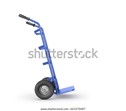 |
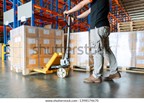 |
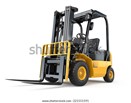 |
 |
|
Trolleys/wheelbarrows
|
Pallet jack
|
Forklift
|
Electrical pallet jack tuck
|
Other considerations
Other considerations when handling materials using mechanical materials include:
- referring to the JSEA
- constantly reviewing banding and strapping when moving materials
- maintaining housekeeping standards by cleaning up and disposing of any items that could cause trip, slip, and falls hazards
- maintaining situational awareness throughout tasks to keep an eye out for potential hazards.
- ensuring they you don’t introduce new hazards as you work
- taking action to address/report hazards as they arise
- asking for help/advice
- warning others of your movements.
When preparing specific types of equipment and materials, there comes with it, a process that needs to be carried out to ensure they have been moved safely to minimise the risk of injury or damage. Each of the materials has been broken down into the following categories.
Concrete blocks or bricks
Concrete blocks or bricks are usually used on the exterior of projects for facades, building houses, retaining walls or fences and driveways among many other uses. They are amongst some of the common materials you will come across throughout your career.
- Use a wheelbarrow or brick trolley to move small amounts.
- Stack carefully and evenly in wheelbarrows and on brick trolleys.
- Stack majority of weight over wheel/s.
- Use a forklift or pallet jack to move them while still stacked on pallets.
- Carefully remove any banding and wrapping.
- Carefully handle bricks when sorting and stacking to avoid damage.
- Wear gloves to avoid hand abrasions, grazes and cuts.
- Use manual handling techniques to avoid injury from repetitive bending and lifting
- Take breaks if sorting and stacking large amounts.
HARRY COMMENT: WITH THE BULLET POINTS ABOVE, CAN YOU PLEASE DRAW THEM IN A GRAPHIC LIKE BELOW WITH AN IMAGE AT THE CENTER.

Insulation
Insulation is used between walls and the ceiling (this is known as insulation batts) it is a material that is designed for regulating temperature and reducing sound. Special ratings are applied to types of insulation which must align with Australian standards and needs certification
- Refer to SDS.
- Use PPE including gloves, hard hat, goggles, masks, high-vis and long-sleeved clothing to protect from fibres.
- Protect from damage by covering or storing in a shed or similar.
- Avoid storing in direct sunlight for long periods and keep away from wet areas.
- Use trolleys, forklifts, or other equipment to move, or move manually without equipment.
- Keep in original packaging.
- Do not remove labelling.
- Ensure insulation is not stored on the ground/floor.
HARRY COMMENT: WITH THE BULLET POINTS ABOVE, CAN YOU PLEASE DRAW THEM IN A GRAPHIC LIKE BELOW WITH AN IMAGE AT THE CENTER.

Joinery components
Joinery components refer to cupboards, framework, windows, and vanities. Joinery components are not usually delivered to a site, for example a house, until the house is at the ‘lock up’ stage, that is, the stage in which the house can be locked up.
- Wrap and/or cover to protect from damage.
- Protect from weather conditions (sun, wind, rain).
- Store off the ground to protect from water damage.
- Store glass in an upright position.
- Use mechanical handling for larger and heavier joinery components.
- Use two-person handling techniques for items such as cabinetry, doors, windows etc.
- Place components close to relevant work areas and sort according to room/type (ie joinery components for kitchen, laundry, bathroom etc).
HARRY COMMENT: WITH THE BULLET POINTS ABOVE, CAN YOU PLEASE DRAW THEM IN A GRAPHIC LIKE BELOW WITH AN IMAGE AT THE CENTER.

Scaffolding components
Scaffolding can be identified in various categorises, some of which include internal and external, and for the purpose of safety. It is a compulsory WHS requirement to have a secure scaffold on the external of building development and must be tagged and certified by a qualified scaffold erecter.
- Wear PPE such as hard hats, gloves, protective footwear, high-vis.
- Use cranes, hoists, pallet jacks or trolleys to move components and avoid manual lifting.
- Make sure scaffolding is located as close as possible to work area.
- Make sure scaffolding is not stored when wet.
- Use blocking to stop tubing from rolling.
- Sort and stack according to size/lengths
- Keep stacks to a stable height.
- Keep scaffolding clear of the ground.
- Structural steel sections, components and reinforcing bars
- Wear PPE such as hard hats, gloves, protective footwear, high-vis.
- Use cranes, hoists, pallet jacks or trolleys to move components – steel components are generally quite heavy.
- Use two-person lifting if weight is considered suitable for such lifting and moving.
- Store on stable and level surface.
- Store in a dry environment to protect from corrosion.
- Keep steel components clear of the ground.
- ollow chocking procedures.
- Be aware of banding/strapping and its hazards.
HARRY COMMENT: WITH THE BULLET POINTS ABOVE, CAN YOU PLEASE DRAW THEM IN A GRAPHIC LIKE BELOW WITH AN IMAGE AT THE CENTER.

Lengths of timber
Lengths of timber are commonly used in frame works of buildings, flooring, some types of furniture and stairs (just to name a few).
- Wear PPE such as hard hats, gloves, protective footwear, high-vis.
- Sort and stack according to lengths/sizes and type.
- Stack in order of longest (bottom) to shortest.
- Store close to work areas.
- Stack timber off the ground.
- Stack carefully to ensure timber does not bend or warp.
- Use cranes, hoists, pallet jacks or trolleys to move if on pallets.
- Use manual handling or two-person lifting where timber may be quite long or bulky, but still light enough to move without mechanical equipment.
- Cover timber or placed in a covered area to protect from elements.
- Make sure there are gaps to prevent from damp.
- Consider types of timber, as some may have specific storage requirements.
HARRY COMMENT: WITH THE BULLET POINTS ABOVE, CAN YOU PLEASE DRAW THEM IN A GRAPHIC LIKE BELOW WITH AN IMAGE AT THE CENTER.

Reconstituted Timber
Reconstituted timber is a sustainable product made from unwanted plastics and woods and is then used to create decking and cladding.
- Wear PPE such as hard hats, gloves, protective footwear, goggles, high-vis.
- Stack flat to avoid warping/bending.
- Sort according to type and size.
- Store in cool, dark, ventilated and dry place.
- Store clear of the ground.
- Use mechanical lifting to move boxes/packages.
- Consider types of timber, as some may have specific storage requirements.
HARRY COMMENT: WITH THE BULLET POINTS ABOVE, CAN YOU PLEASE DRAW THEM IN A GRAPHIC LIKE BELOW WITH AN IMAGE AT THE CENTER.

Metal sheeting
Metal sheeting comes in a variety of lengths and is commonly used in commercial, industrial, and residential industries for the purpose of roofing, flooring, fencing and ornaments. Metal sheeting is made from various types of metal including aluminium, copper, brass, corrugated and galvanised just to name a few.
- Wear PPE such as hard hats, gloves, protective footwear, high-vis.
- Use mechanical lifting.
- Store in dry, ventilated environment to avoid corrosion.
- Stack neatly to maintain stability.
- Sort and stack according to size, colour, type.
- Cover to protect from elements.
- Store clear of the ground.
HARRY COMMENT: WITH THE BULLET POINTS ABOVE, CAN YOU PLEASE DRAW THEM IN A GRAPHIC LIKE BELOW WITH AN IMAGE AT THE CENTER.

Plaster/fibre cement sheeting
Plaster/ fibre cement sheeting may also be known as gyprock is commonly used for the internal and external of commercial, industrial, and residential properties for a range of purposes including walls and ceilings. Fibre cement sheeting is usually made from cement, sand and cellulose fibres and is water resistant and will not disintegrate if exposed to water.
- Wear PPE such as hard hats, gloves, protective footwear, goggles, masks, high-vis.
- Store flat and level.
- Do not stand or lean sheeting on its edge unless it is stored in purpose-designed racks.
- Handle carefully as it is easy to chip or break.
- Store in a dry, ventilated area.
- Store clear of the ground.
- Maintain wraps/packaging until ready for installation.
- Cover to protect from weather if it must be stored outside.
- Support with equally spaced bearers.
HARRY COMMENT: WITH THE BULLET POINTS ABOVE, CAN YOU PLEASE DRAW THEM IN A GRAPHIC LIKE BELOW WITH AN IMAGE AT THE CENTER.

Paints, sealers and other finishing materials
Paints and sealers are usually used towards the end of a project and add to the aesthetics. Many of these products are flammable and therefore should not be used in proximity to open flames. They produce a strong odour and extra care should be taken when using them as long-term inhalation can have health implications, therefore a mask should be worn when using these substances.
- Refer to relevant SDS.
- Wear PPE such as hard hats, gloves, protective footwear, goggles, masks, high-vis.
- Ensure tins/containers/bottles are firmly sealed.
- Ensure tins/containers/bottles are stored upright.
- Store in cool, dry area away from sources of ignition and direct sunlight.
- Store in a well-ventilated area.
- Consider incompatibility with other substances when storing (ie oxidising agents, corrosives etc).
- Do not transfer into other containers.
- Use trolleys to transfer heavy loads.
HARRY COMMENT: WITH THE BULLET POINTS ABOVE, CAN YOU PLEASE DRAW THEM IN A GRAPHIC LIKE BELOW WITH AN IMAGE AT THE CENTER.

Structural steel sections
Structural steel sections are commonly used for beams and columns. They are manufactured in rolling mills where they are categorised by their shape. Structural steel sections are made from carbon, high strength alloy and stainless steel.
- Wear PPE such as hard hats, gloves, protective footwear, high-vis.
- Use cranes, hoists, pallet jacks or trolleys to move components – steel components are generally quite heavy.
- Use two-person lifting if weight is considered suitable for such lifting and moving.
- Store on stable and level surface.
- Store in a dry environment to protect from corrosion.
- Keep steel components clear of the ground.
- Follow chocking procedures.
- Be aware of banding/strapping and its hazards.
HARRY COMMENT: WITH THE BULLET POINTS ABOVE, CAN YOU PLEASE DRAW THEM IN A GRAPHIC LIKE BELOW WITH AN IMAGE AT THE CENTER.

Reinforcement materials
Once you have become familiar with the various types of materials, consideration needs to be taking when moving them. After you have planned on moving the materials, you will need to consider how you are going to move them and evaluate the route you are going to take. These six steps will help you when coming up with a route to transport the materials.
- Check for new hazards.
- Ensure that signs and barriers are in place.
- Check for trip hazards, obstructions, rough or uneven ground.
- Familiarise yourself with other work that is occurring on site.
- Become aware of any vehicles moving around on site.
- Look at how materials could become damaged while you are moving them.
This final check will help to ensure that you and the materials that you are moving will arrive safely.
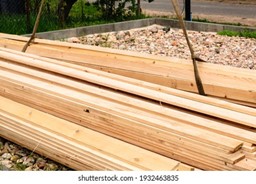
Care does not need to be taken through the transporting of materials alone. You will also need to consider how you are planning on unloading these materials. The techniques that you use to unload materials can present a safety risk to you or others around you along with the risk of damaging the materials themselves, work that has already been completed or materials that have already been delivered. Consider the following tips.
|
No. |
Tip |
|
1 |
Use signs and barricades where necessary. |
|
2 |
Follow workplace procedures. |
|
3 |
Place barrows and trolleys on a stable area before unloading. |
|
4 |
When unloading wheelbarrows and trolleys, ensure that you unload materials in even layers so that you don’t unbalance the trolley or barrow and cause it to tip. |
|
5 |
Ensure that you unload in an area which is not going to cause an obstruction to a walkway, access or egress. |
|
6 |
Ensure that you unload to an area that is not going to impede the work of others. |
|
7 |
Use safe manual handling techniques when unloading. |
|
8 |
Unload in a logical sequence and locate materials where they can be accessed as they will be used. |
|
9 |
Unload onto pallets or trolleys if materials will need to be moved again. |
|
10 |
Regardless of whether it is metal or plastic, banding can be sharp and should be cut with tin snips or scissors. |
|
11 |
Wear gloves, glasses and other PPE when removing banding. |
|
12 |
Consider the order that you cut banding to help prevent recoil. |
|
13 |
Dispose of banding immediately – it can be a trip/slip hazard. |
|
14 |
When removing pallet wrap, be careful not to slice through to the materials underneath. |
|
15 |
Dispose of pallet wrap responsibly and immediately. Pallet wrap is a recyclable item. |
|
16 |
Stack materials safely (see the next section) as they are unloaded. |
|
17 |
Be careful when releasing banding that materials don’t fall from a bundle or stack. |
|
18 |
Do not release banding from a bundle of sheet material that is stacked on its edge unless it is standing in a purpose-built rack. |


